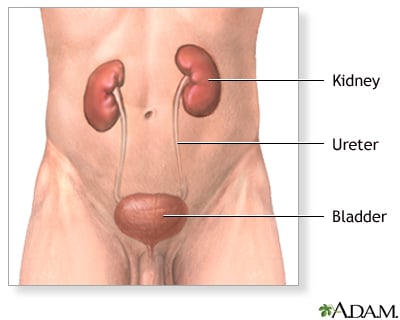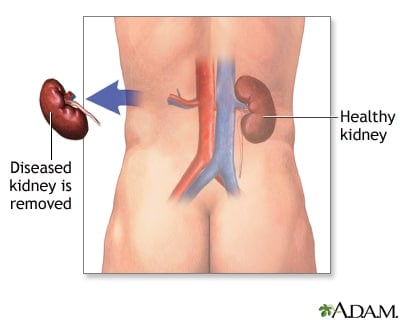Table of Contents
Kidney removal, or nephrectomy, is surgery to remove all or part of a kidney. It may involve:
- Part of one kidney removed (partial nephrectomy).
- All of one kidney removed (simple nephrectomy).
- Removal of one entire kidney, surrounding fat, and the adrenal gland (radical nephrectomy). In these cases, neighboring lymph nodes are sometimes removed.
How is nephrectomy done?
This surgery is done in the hospital while you are asleep and pain-free (general anesthesia). The procedure can take 3 or more hours.
Simple nephrectomy or open kidney removal:
- You will be lying on your side. Your surgeon will make an incision (cut) up to 12 inches or 30 centimeters (cm) long. This cut will be on your side, just below the ribs or right over the lowest ribs.
- Muscle, fat, and tissue are cut and moved. Your surgeon may need to remove a rib to do the procedure.
- The tube that carries urine from the kidney to the bladder (ureter) and blood vessels are cut away from the kidney. The kidney is then removed.
- Sometimes, just a part of the kidney may be removed (partial nephrectomy).
- The cut is then closed with stitches or staples.
Radical nephrectomy or open kidney removal:
- Your surgeon will make a cut about 8 to 12 inches (20 to 30 cm) long. This cut will be on the front of your belly, just below your ribs. It may also be done through your side.
- Muscle, fat, and tissue are cut and moved. The tube that carries urine from the kidney to the bladder (ureter) and blood vessels are cut away from the kidney. The kidney is then removed.
- Your surgeon will also take out the surrounding fat, and sometimes the adrenal gland and some lymph nodes.
- The cut is then closed with stitches or staples.
Laparoscopic kidney removal:
- Your surgeon will make 3 or 4 small cuts, most often no more than 1 inch (2.5 cm) each, in your belly and side. The surgeon will use tiny probes and a camera to do the surgery.
- Towards the end of the procedure, your surgeon will make one of the cuts larger (about 4 inches or 10 cm) to take out the kidney.
- The surgeon will cut the ureter, place a bag around the kidney, and pull it through the larger cut.
- This surgery may take longer than an open kidney removal. However, most people recover faster and feel less pain after this type of surgery when compared to the pain and recovery period following open surgery.
Sometimes, your surgeon may make a cut in a different place than described above. Some hospitals and medical centers are doing this surgery using robotic tools (in which case the surgery is called robotic nephrectomy).
Why is nephrectomy surgery performed?
Kidney removal may be recommended for:
- Someone donating a kidney
- Birth defects
- Kidney cancer or suspected kidney cancer
- A kidney damaged by infection, kidney stones, or other problems
- To help control high blood pressure in someone who has problems with the blood supply to their kidney
- Very bad injury (trauma) to the kidney that cannot be repaired
What are the risks of nephrectomy surgery?
Risks of any surgery are:
- Blood clots in the legs that may travel to the lungs
- Breathing problems
- Infection, including in the surgical wound, lungs (pneumonia), bladder, or kidney
- Blood loss
- Heart attack or stroke during surgery
- Reactions to medicines
Risks of this procedure are:
- Injury to other organs or structures
- Kidney failure (chronic kidney disease) in the remaining kidney
- After one kidney is removed, your other kidney may not work as well for awhile
- Hernia of your surgical wound
How do I prepare for nephrectomy surgery?
Always tell your health care provider:
- If you could be pregnant
- What drugs you are taking, even drugs, supplements, vitamins, or herbs you bought without a prescription
During the days before the surgery:
- You will have blood samples taken in case you need a blood transfusion.
- You may be asked to stop taking aspirin, ibuprofen (Advil, Motrin), naproxen (Aleve, Naprosyn), Clopidogrel (Plavix), warfarin (Coumadin), and other blood thinners.
- Ask your provider which drugs you should still take on the day of the surgery.
- Do not smoke. This will help you to recover quicker.
On the day of the surgery:
- You will most often be asked not to drink or eat anything after midnight the night before the surgery.
- Take the drugs as you have been told, with a small sip of water.
- You will be told when to arrive at the hospital.
Recovering after the nephrectomy surgery
You will stay in the hospital for 1 to 7 days, depending on the type of surgery you have. During a hospital stay, you may:
- Be asked to sit on the side of the bed and walk on the same day of your surgery
- Have a tube, or catheter, that comes from your bladder
- Have a drain that comes out through your surgical cut
- Not be able to eat the first 1 to 3 days, and then you will begin with liquids
- Do breathing exercises
- Wear special stockings, compression boots, or both to prevent blood clots
- Receive shots under your skin to prevent blood clots
- Receive pain medicine into your veins or pills
Recovering from open surgery may be painful because of where the surgical cut is located. Recovery after a laparoscopic procedure is most often quicker, with less pain.
What to Expect at Home
Recovering from kidney removal most often takes around 3 to 6 weeks. You may have some of these symptoms:
- Pain in your belly or on the side where you had the kidney removed. The pain should get better over several days to a week.
- Bruising around your wounds. This will go away on its own.
- Redness around your wounds. This is normal.
- Pain in your shoulder if you had laparoscopy. The gas used in your belly can irritate some of your abdomen muscles and radiates pain to your shoulder.
Activity after nephrectomy surgery
Plan to have someone drive you home from the hospital. DO NOT drive yourself home. You may also need help with everyday activities for the first 1 to 2 weeks. Set up your home so it is easier to use. You should be able to do most of your regular activities within 4 to 6 weeks. Before then:
- DO NOT lift anything heavier than 10 pounds (4.5 kilograms) until you see your doctor.
- Avoid all strenuous activity, including heavy exercises, weightlifting, and other activities that make you breathe hard or strain.
- Taking short walks and using the stairs is OK.
- Light housework is OK.
- DO NOT push yourself too hard. Slowly increase the amount of time and the intensity of your exercise. Wait until you follow up with your health care provider to be cleared for exercise.
To manage your pain:
- Your provider will prescribe pain medicines for you to use at home.
- If you are taking pain pills 3 or 4 times a day, try taking them at the same times each day for 3 to 4 days. They may work better this way. Be aware that the pain medicine can cause constipation. Try to maintain normal bowel habits.
- Try getting up and moving around if you are having some pain. This may ease your pain.
- You may put some ice over the wound. But keep the wound dry.
Press a pillow over your incision when you cough or sneeze to ease discomfort and protect your incision.
Make sure your home is safe as you are recovering.
Wound care after nephrectomy surgery
You will need to keep your incision area clean, dry, and protected. Change your dressings the way your provider taught you to.
- If stitches, staples, or glue was used to close your skin, you may take a shower.
- If tape strips were used to close your skin, cover the wounds with plastic wrap before showering for the first week. DO NOT try to wash the tape strips off. Let them fall off on their own.
DO NOT soak in a bathtub or hot tub, or go swimming, until your provider tells you it is OK.
Diet after nephrectomy surgery
Eat a normal diet. Drink 4 to 8 glasses of water or liquids a day, unless you are told otherwise. If you have hard stools:
- Try to walk and be more active. But DO NOT overdo it.
- If you can, take less of some of the pain medicines your doctor gave you. Some can cause constipation.
- Try a stool softener. You can get these at any pharmacy without a prescription.
- Ask your provider what laxatives you can take.
- Ask your doctor about foods that are high in fiber, or try psyllium (Metamucil).
When to Call the Doctor
- You have a temperature above 100.5°F (38°C)
- Your surgical wounds are bleeding, are red or warm to the touch, or have a thick, yellow, green, or milky drainage
- Your belly swells or hurts
- You have nausea or vomiting for more than 24 hours
- You have pain that does not get better when you take your pain medicines
- It is hard to breathe
- Cough that does not go away
- You cannot drink or eat
- You cannot pee (urinate)
What is the outlook (prognosis) after nephrectomy?
The prognosis depends on what the pathologist finds on examining the removed kidney. The pathologist will provide a tumor stage and tumor grade, which will be critical in determining your prognosis and treatment options. You can learn more about how to understand pathology results here.
In terms of kidney function, the outcome is most often good with removal of a single kidney. Removal of both the kidneys may need hemodialysis or a kidney transplant.
Alternative Names
Nephrectomy; Simple nephrectomy; Radical nephrectomy; Open nephrectomy; Laparoscopic nephrectomy; Partial nephrectomy




